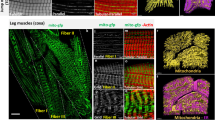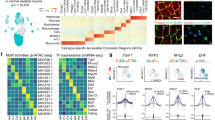Abstract
In vertebrate and invertebrate muscles, the expression of fatty acid binding proteins (FABP) is induced by long chain fatty acids. To identify the fatty acid response elements that mediate this up-regulation, the gene of the FABP expressed in locust flight muscle was cloned, and its upstream sequences analyzed for potential regulatory elements. Comparison with other muscle FABP promoters revealed the presence of a 19-bp imperfect inverted repeat sequence that contains two hexanucleotide half sites (AGTGGT and ATGGGA), interspersed by 3 nucleotides. The promoter activity was studied with reporter gene constructs in L6 myoblasts, in which H-FABP expression is stimulated by long-chain fatty acids in a similar manner as in adult cardiomyocytes. The 19 bp element, located 180 bp upstream of the transcription start site, was found to be essential for the fatty acid induction of gene expression, and gel shift analysis confirmed that this fatty acid response element is capable of binding nuclear proteins both from rat myoblasts and locust muscle in the presence of fatty acids. A similar, but reverse sequence that is present upstream of all mammalian H-FABP promoters may modulate the expression of the rat H-FABP gene.
Similar content being viewed by others
References
Vogel Hertzel A, Bernlohr DA: The mammalian fatty acid-binding protein multigene family: Molecular and genetic insights into function. Trends Endocrinol Metab 11: 175–180, 2000
Veerkamp JH, van Moerkerk HTB: Fatty acid binding protein and its relation to fatty acid oxidation. Mol Cell Biochem 123: 101–106, 1993
van Breda E, Keizer HA, Vork MM, Surtel DAM, de Jong YF, van der Vusse GJK, Glatz JFC: Modulation of fatty-acid-binding protein content of rat heart and skeletal muscle by endurance training and testosterone treatment. Pflügers Arch 421: 274–279, 1992
Guglielmo CG, Haunerland NH, Williams TD: Fatty acid binding protein, a major protein in the flight muscle of migrating Western Sandpipers. Comp Biochem Physiol 119B: 549–555, 1998
Chen X, Haunerland NH: Fatty acid binding protein expression in locust flight muscle. Induction by flight, adipokinetic hormone, and low density lipophorin. Insect Biochem 24: 573–579, 1994
Glatz JF, van Breda E, Keizer HA, de Jong YF, Lakey JR, Rajotte RV, Thompson A, van der Vusse GJ, Lopaschuk GD: Rat heart fatty acidbinding protein content is increased in experimental diabetes. Biochem Biophys Res Commun 199: 639–646, 1994
Van Bilsen M, de Vries JE, van der Vusse GJ: Long-term effects of fatty acids on cell viability and gene expression of neonatal cardiac myocytes. Prostaglandins Leukotrienes Essent Fatty Acids 57: 39–45, 1997
van der Lee KA, Vork MM, De Vries JE, Willemsen PH, Glatz JF, Reneman RS, van der Vusse GJ, van Bilsen M: Long-chain fatty acidinduced changes in gene expression in neonatal cardiac myocytes. J Lipid Res 41: 41–47, 2000
van Bilsen M, van der Vusse GJ, Reneman RS: Transcriptional regulation of metabolic processes: Implications for cardiac metabolism. Pflügers Archs 437: 2–14, 1998
Mangelsdorf DJ, Thummel C, Beato M, Herrlich P, Schutz G, Umesono K, Blumberg B, Kastner P, Mark M, Chambon P et al.: The nuclear receptor superfamily: The second decade. Cell 83: 835–839, 1995
Wolfrum C, Ellinghaus P, Fobker M, Seedorf U, Assmann G, Börchers T, Spener F: Phytanic acid is ligand and transcriptional activator of murine liver fatty acid binding protein. J Lipid Res 40: 708–714, 1999
Frohnert BI, Hui TY, Bernlohr DA: Identification of a functional peroxisome proliferator-responsive element in the murine fatty acid transport protein gene. J Biol Chem 274: 3970–3977, 1999
Braissant O, Foufelle F, Scotto C, Dauca M, Wahli W: Differential expression of peroxisome proliferator-activated receptors (PPARs): Tissue distribution of PPAR-alpha,-beta, and-gamma in the adult rat. Endocrinology 137: 354–366, 1996
Zhang J, Rickers-Haunerland J, Dawe I, Haunerland, NH: Structure and chromosomal location of the rat gene encoding the heart fatty acidbinding protein. Eur J Biochem 266: 347–351, 1999
Wu Q, Andolfatto P, Haunerland NH: Cloning and sequence of the gene encoding the muscle fatty acid binding protein from the desert locust, Schistocerca gregaria. Insect Biochem Mol Biol 31: 553–562, 2001
Rodriguez B, Severson D: Preparation of cardiomyocytes. In: J.H. McNeill (ed). Biochemical Techniques in the Heart. CRC Press, Boca Raton, FL, 1997, pp 101–115
Chang W, Rickers-Haunerland J, Haunerland NH: Induction of cardiac FABP gene expression by long chain fatty acids in cultured rat muscle cells. Mol Cell Biochem 221: 127–132, 2001
Wu Q, Haunerland NH: A novel fatty acid response element controls the expression of the flight muscle FABP gene of the desert locust, Schistocerca gregaria. Eur J Biochem 268: 5894–5900, 2001
Haunerland NH, Andolfatto P, Chisholm JM, Wang Z, Chen X: Fatty acid binding protein in locust flight muscle. Developmental changes of expression, concentration, and intracellular distribution. Eur J Biochem 210: 1045–1051, 1992
Wolfrum C, Borrmann CM, Börchers T, Spener F: Fatty acids and hypolipidemic drugs regulate peroxisome proliferator-activated receptors alpha - and gamma-mediated gene expression via liver fatty acid binding protein: A signaling path to the nucleus. Proc Natl Acad Sci USA 98: 2323–2328, 2001
Author information
Authors and Affiliations
Rights and permissions
About this article
Cite this article
Wu, Q., Chang, W., Rickers-Haunerland, J. et al. Characterization of a new fatty acid response element that controls the expression of the locust muscle FABP gene. Mol Cell Biochem 239, 173–180 (2002). https://doi.org/10.1023/A:1020554824176
Issue Date:
DOI: https://doi.org/10.1023/A:1020554824176




